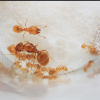








My Main Journal | My Neivamyrmex Journal | My Ant Adoption | My YouTube
Join the TennesseeAnts Discord Server! https://discord.gg/JbKwPgs
Camponotus cf. hyatti.
Camponotus subbarbatus.
Camponotus hyatti is only found in western North America.
Edited by AntsBC, May 28 2019 - 10:15 AM.
Camponotus subbarbatus.
Camponotus hyatti is only found in western North America.
You're gonna need more Test tubes at this rate!!! ![]()
![]()
![]()
Billy
Currently keeping:
Camponotus chromaiodes
Camponotus castaneus
Formica subsericea
You're gonna need more Test tubes at this rate!!!






Edited by CatsnAnts, May 28 2019 - 11:28 AM.
Edited by CatsnAnts, May 28 2019 - 12:19 PM.
No.
This is C. subbarbatus. Dead specimens often don’t look like the living counterpart.
Maybe post pics of both for comparison?
Billy
Currently keeping:
Camponotus chromaiodes
Camponotus castaneus
Formica subsericea
, and one branch in particular happened to have a wasp nest/shell, but I’ll just call it an acorn for the sake of it.
Is this what you mean?

Billy
Currently keeping:
Camponotus chromaiodes
Camponotus castaneus
Formica subsericea
Maybe post pics of both for comparison?
Maybe post pics of both for comparison?
Will do! And also about the picture, it is similar to that except that the shell is brown and VERY hard. I figured out that a lone wasp made it.
Yes these are more fresh they eventually hardened too we call them Oak apple galls. ![]()
Billy
Currently keeping:
Camponotus chromaiodes
Camponotus castaneus
Formica subsericea
My Main Journal | My Neivamyrmex Journal | My Ant Adoption | My YouTube
Join the TennesseeAnts Discord Server! https://discord.gg/JbKwPgs

I also have C. subbarbatus and they look nothing alike. These are C. hyatti. Antweb is often wrong. Try antmaps.
0 members, 1 guests, 0 anonymous users